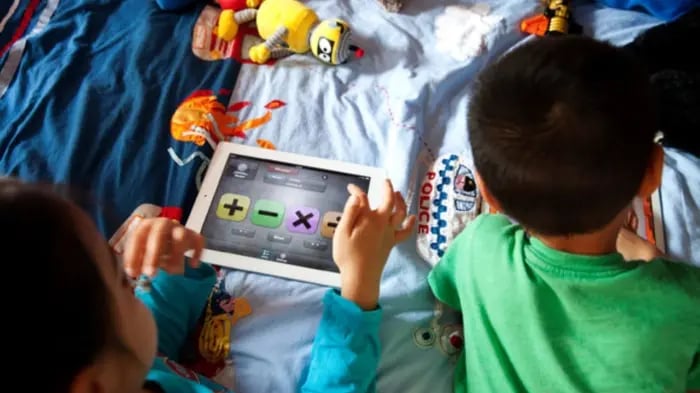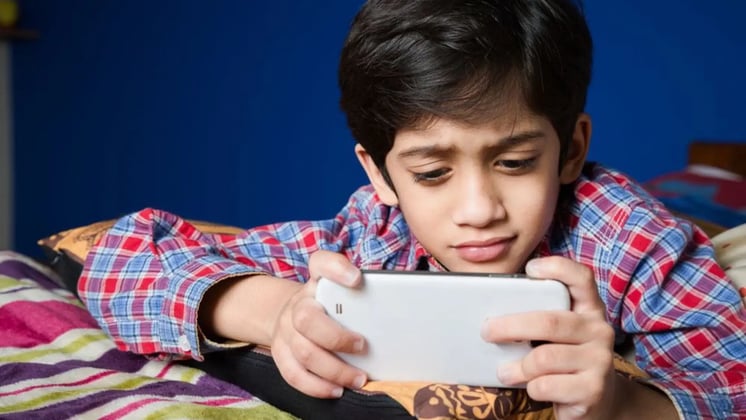- Observe First, Chastise Later
- Establish Tech-Free Zones And Hours
- Advocate The ‘Earned Time’ Model
- Model Ideal Behavior
- Prioritize Family Time And Outdoor Play
Introduction
The crisp, cool air, early sunset, and the magnetic pull of a cozy blanket make it difficult for parents to curb their kids’ digital lives during winter. The season, by its very nature, encourages kids to huddle indoors over glowing screens. This can cause a creeping rise in screen time from a carefully rationed activity to an almost default setting. While the convenience of digital babysitting is undeniable, it is ideal to avoid relying on it. Too much screen time can undermine a child’s development, sleep quality, and physical health.
But it is imperative to be realistic. For example, if your child is currently online 4 hours a day, a sudden, non-negotiable drop to 1 hour is but a recipe for conflict. Instead, agree on a gradual reduction, perhaps cutting it by 30 minutes each week until you reach a healthy target. To understand how much screen time is ideal for kids, you can refer to a 2019 review article by the Indian Pediatrics. It clarifies that for babies, it is ideal to restrict screen time to video calling only. Toddlers should only watch high-quality educational content together with their parents for less than an hour. For children, allow a maximum of an hour of digital time under supervision, while teenagers should not spend more than 2 hours online daily.
Tips For Managing Screen Time During Winter

A successful winter strategy does not begin with a rigid clock-watching regime, but with a proper family meeting and written plan. Involve your children in the process as well. It will make them more likely to follow rules that they helped create. The following tips have been based on the information provided by the 2020-2021 Action Plan and Guidelines of the Indian Academy of Pediatrics (IAP) and a systematic 2023 review of Elsevier.
Observe First, Chastise Later
Before setting a time limit for the entire family, observe your kids and other family members' recreational screen time. This will help identify key patterns that need to be addressed and broken. It also helps set a realistic baseline to start on, instead of a direct, rigid reduction in screen time, which leads to family discontent. Gradually curb screen time by replacing that particular form of leisure with some fruitful entertainment and activities.
Establish Tech-Free Zones And Hours

Consistency is the foundation of any successful disciplinary boundary. Enforce non-negotiable ‘Screen-Free Zones’ (e.g., the dining table, bedrooms, study room) and ‘Screen-Free Times’ (e.g., all family meals, the hour before bedtime, exam season, and so on). Try to charge all devices in a central, communal zone, away from bedrooms. It is a powerful and practical step to protect essential sleep hygiene. According to a 2021 article published in the Indian Journal of Sleep Medicine, blue light exposure in kids before bed is scientifically linked to disrupted sleep, which impairs attention and mood the next day. Instead, guide them to focus on eating mindfully and connecting consciously with parents during meal time or family gatherings.
Advocate The ‘Earned Time’ Model
Depict screen usage not as an entitlement, but as an activity to be balanced with other responsibilities and pursuits in life. This is particularly effective for older children and teenagers. Implement an ‘Earned Time’ system, that is, 30 minutes of independent reading, an hour of creative play, or the completion of a household chore that will ‘earn’ them a corresponding amount of screen time. This subtly shifts the child’s focus from passively demanding entertainment to actively contributing to their daily routine.
Model Ideal Behavior

Parents must intentionally model the healthy balance they are trying to instill. This is because children are exquisitely tuned to their parents' habits. If a parent is constantly scrolling on their screen during family time, the child will internalize that behaviour as normal and essential. Limit your own phone use during designated family activities. Put your devices away when your child is speaking to you. Turn off background television. These small, deliberate actions send a clear message to kids: that face-to-face interaction, creativity, and the physical world are more valuable than the endless ebb and flow of digital content.
Prioritize Family Time And Outdoor Play
The most common reason children revert to screens is simple—boredom. Managing screen time in winter is less about taking the device away and more about filling the inevitable void of entertainment and excitement with compelling, non-digital alternatives. Plan family events, such as board game nights or baking, that help both kids and parents release stress and bond together. To encourage movement and physical activity, you can also design indoor obstacle courses, family dance parties, yoga videos, or just a good old-fashioned game of hide-and-seek as well, to get the muscles moving. Encourage and facilitate time outdoors, even if it is short. According to a 2021 review article of the Indian Journal of Medical Research, 20 to 25 minutes of brisk activity, such as playing tag under the mellow winter sun or just hosting a picnic, boosts physical health, provides essential Vitamin D, and offers a crucial mental break from the confines of the house.
Conclusion
Do not let screen time management become another source of parent-child conflict. We are aiming for connection, not perfection. This time of the year is a genuine struggle, and sometimes survival can mean occasionally leaning on the digital babysitter for an extra 30 minutes. Forgive yourself those moments.
Instead of viewing the tablet or phone as the villain, see it as a tool that simply needs boundaries. Try leaning into the warmth of your family bonding—be it an extra-long, candle-lit board game night or a cozy evening of shared reading instead of separate devices. When you do allow the screens, sit with kids. Talk about what they are watching or playing as the small act of co-viewing instantly transforms isolation into interaction. What truly matters is not the number on the screen timer, but the quality of time you spend together making memories.
Kaushiki Gangully is a content writing specialist with a passion for children's nutrition, education, and well-being. With more than five years of writing experience and a science-based background, she provides nuanced insights to help families raise happy, healthy kids. Kaushiki believes in making learning and healthy eating fun, empowering parents with practical, easy advice.
The views expressed are that of the expert alone.
The information provided in this content is for informational purposes only and should not be considered a substitute for professional medical advice, diagnosis, or treatment. Always seek the advice of your physician or another qualified healthcare provider before making any significant changes to your diet, exercise, or medication routines. This is a sponsored article.
References
https://www.indianpediatrics.net/sep2019/sep-773-788.htm
https://iapindia.org/pdf/Screentime-Guidelines-for-Parents-Ch-005.pdf
https://pmc.ncbi.nlm.nih.gov/articles/PMC10201873/
















